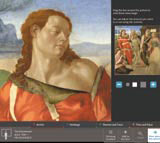In touch with the masses
Interactive features are now part of our world, so galleries are feeling the pressure to develop similar systems before it’s too late, says Mike Exon

Exhibition design feels like it is on the brink at the moment. Take a visit to a ‘classically’ designed museum exhibition and you might see why. Does the collection look dated? Is it hungry for technological empowerment? But it never used to feel like this, did it?
A handful of galleries and museums, not to mention shops, bars and offices, have begun to offer us interactive experiences that are now so powerful that visitors to other exhibitions can be forgiven for feeling underwhelmed. We expect more than walking through room upon room of low-lit artefacts squinting at tiny cardboard squares of eight-point blurb.
The burgeoning field of interaction design, a discipline that has given the Web design consultancies of old a new lease of life, is no longer something brave and experimental as far as the culture-loving public is concerned. It has become the norm. How far to turn up the volume is the only real question remaining.
The case for or against technology is not really in dispute. The real issue is on its level of visibility. Does the public want or need to see the wires? How unadulterated, how non-virtual should their experiences be?
Art galleries are slap bang in the middle of this debate right now due to the nature of their exhibits: paintings, sculpture and other 3D artworks demand the physical attention of visitors, after all. So the question was front and centre for the National Gallery, which this week unveils the design of its £500 000 Art Start project.
Five years in development, Art Start is a public multimedia system that brings technology to bear on the traditional painting – or 2300 of them, to be precise. Since the gallery has taken the time to make high resolution scans of its collection, it wants to show off the results as part of the visitor experience. The gallery is replacing its existing Micro Gallery with a redesigned multimedia centre and café, housing 12 touch-screen Art Start kiosks and printing facilities. Visitors can use the system to read about particular paintings in the gallery, as well as view them in incredible detail. Ten further kiosks will be located in the gallery’s lower hall and two key walkways will also benefit from the terminals.
The gallery’s new media department, in collaboration with London interactive design group Nykris, has spearheaded the interaction design work for Art Start.
National Gallery deputy head of new media Steve Dale says the starting point for the technology was to enhance the gallery’s existing collection, but not eclipse it. ‘The gallery’s works of art are beautiful things in themselves. We didn’t want this to be about the technology but [rather] about enabling visitors to engage with the collection in new and interesting ways,’ says Wade.
‘We designed the kiosks with a simple touch-screen interface, because keyboards and mice smack of computers. This can still be quite off-putting for some people. Art Start is not designed to be on-line, so it doesn’t require a level of computer literacy from the user. It’s for everyone,’ says Nykris managing director Philip Read.
Art Start’s design dovetails with the aesthetic direction laid down by Holmes Wood for the gallery signage and graphics, Wade also points out (DW 29 July 2004). While traditional institutions like art galleries continue to wrestle with aesthetic decisions about how much technology is too much – how to keep it real but enhanced – others are forging further ahead.
The Public, the Midland’s interactive arts centre, is set to open next year in a blaze of exhibition glory. Built by Alsops, with interiors by Ben Kelly Design and branding by Wolff Olins, the Lottery- funded project promises to reconfigure the way art is delivered, through some radical interactive designs being prototyped by AllofUs and Digit.
Both groups have always maintained that when it comes to galleries and museums, the rule of thumb is still to avoid doing tech for tech’s sake.
After the success of its work on the Energy Wing of the Science Museum last year, AllofUs unveiled its latest exhibit at the museum on Monday, an installation called Websphere that brings to life the mechanics behind an IBM software system of the same name. As the winner of the MacRobert Award for engineering achievement, Websphere was invited to display in the museum foyer. This posed a problem, so the design group was called in by Science Museum head of exhibitions Jo Quinton-Tulloch to give the software a physical dimension.
‘There is no doubt technology is becoming ubiquitous and that applies to museums and galleries too. Curators are starting to think of the technology they can bring to the exhibit. While working with a museum exhibit is one thing and working with an art piece is another, people are realising that interactivity is becoming more and more important in this field, even if it’s used for something as straightforward as signage,’ says AllofUS director Phil Gerard.
‘The critical thing is that technology has to be used sensitively. I think it’s fatal if it takes over and becomes too gimmicky,’ he says.
AllofUs is also working on the museum’s Move Over Einstein exhibition, which opens in March. Targeting 11-to-14-year-olds, it is interaction-heavy to resonate with the short attention span generation. The point is clear. In less than ten years these people will come of age. But will galleries rise to the challenge?
Art Start, National Gallery
• A dedicated café lounge with 12 free-to-use interactive kiosks
• Redesigned terminals at key junctions in the gallery
• Create and print your own gallery tours for free
• E-mail details of your favourite paintings home
• High quality detailed close-ups on all the gallery’s paintings
-
Post a comment



